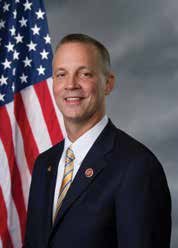Let’s expedite restoration of the Everglades
 by Congressman Curt Clawson (FL-19)
by Congressman Curt Clawson (FL-19)
South Florida is experiencing an ecological and economic disaster not seen since the 2010 BP oil spill. It’s time for action.
Today’s alarming situation is caused by record rainfalls – associated with this winter’s strong El Niño conditions; a phenomenon typically experienced every five years. Unsafe Lake Okeechobee water levels have forced the U.S. Army Corps of Engineers (ACE) to discharge massive volumes of murky, nutrient-laden water into the Gulf of Mexico and Atlantic Ocean. It’s horrific to witness the damage these discharges inflict on our way of life in South Florida. This crisis provides an opportunity to address these water issues with a sense of urgency – with the public will serving as a wind at our back.
Two weeks ago, I introduced H.R. 4436, bipartisan legislation to provide $800 million of emergency funding to expedite repairs
to the Herbert Hoover Dike that surrounds Lake Okeechobee, and requiring completion of this critical project by December 31, 2020 – four to six years ahead of current schedules. My legislation would provide the option of temporarily holding more water in the Lake during periods of heavy rains.
Last week, I introduced the Everglades Land Acquisition Act of 2016 (H.R. 4793) to provide $500 million for the Department of the Interior to purchase land south of Lake Okeechobee. Many experts agree that more storage, filtration, and a flow-way south from the Lake are critical to move clean, naturally filtered fresh water to the Everglades and Florida Bay, instead of dumping nutrient-laden waters and toxins into Florida’s fragile estuaries and coastal regions.
This tragedy is deeply personal to me. I entered public service, at the urging of my parents, to protect the water and beaches in
my home town of Bonita Springs. It breaks my heart, and should concern everyone, to see the filthy plume of dark brown, toxic waters killing or driving away aquatic life – as it blankets South Florida’s beaches, barrier islands, and coastal communities with dead sea grasses, fish, and other creatures.
Much of modern South Florida was formed when man drained the Everglades for agriculture, below Lake Okeechobee. Later, the
Herbert Hoover Dike was built, and natural flows were altered, enabling the once unimaginable development that has occurred.
Unfortunately, much of the unintended ecological consequences of this development, including discharges from Lake Okeechobee, are borne disproportionally by those who depend on or enjoy the estuaries, the Gulf and the ocean waters in South Florida. We lack the infrastructure needed to deal with large water flows in rainy years, like 2016. The current practice of using the St. Lucie and Caloosahatchee Rivers as the drainage pipes for the state should be ended – as soon as possible. It’s just not fair to the people or the critters affected.
SOLUTIONS
By the year 2000, after a century of development, concern for these problems culminated in the Comprehensive Everglades Restoration Plan (CERP) – a long term plan to permanently restore safe, clean water flows throughout south and central Florida – and restore the Everglades. We will never completely restore these flows to what nature provided before development. But CERP is a major step toward this goal. The original projected CERP costs, which the state of Florida and the federal government share 50/50, were $8 billion over 30 years. Of concern, these estimates have now doubled.
Also underway are repairs on the failing Herbert Hoover Dike, and a number of state and federal programs for water storage,
treatment, and conveyance. These include Kissimmee River Restoration, Modified Water Deliveries to Everglades National
Park, Picayune Strand Restoration, Indian River Lagoon, C-43 and C-44 initiatives. I appreciate, and support the significant efforts and investments being made in executing these projects. Nonetheless, the citizens and coastal communities of South Florida still unfairly bear too much of the state’s drainage and flood protection burden.
PROGRESS IS TOO LITTLE AND TOO SLOW
Despite on-going investments, today’s crisis tells us that we’re not acting fast enough – even with the creative and admirable emergency actions taken by the Governor, South Florida Water Management District (SFWMD), and ACE to move water away from the Lake and relieve pressure on the Dike. The current polluted waters heading into the Gulf and Atlantic Ocean are a resounding wake-up call for immediate additional steps to avoid further calamity in subsequent rainy years.
We need to move faster on CERP, a series of more than 60 projects, each of which needs authorization. Completion of CERP is
now seen as beyond 2050.
As currently anticipated, the critical repairs needed on the Dike will not be completed for a decade.
Then there is the Central Everglades Planning Project (CEPP), the next planned Everglades restoration project. Once implemented, CEPP will store, treat, and convey 200,000 acre-feet of Lake water south into the central Everglades. But CEPP is not yet even authorized – and completion could also take another decade. Moreover, Congress has historically authorized water projects (WRDDA) every seven years. We need to speed this up to at least every two years – to stay on top of things.
While I support CERP, Dike repairs, CEPP, and WRDDA – as critical in restoring water flows and protecting South Florida – current schedules are simply unacceptable – especially when considering the high likelihood of another El Niño. Today’s problems will only become more expensive to solve – unless we prioritize and speed up the pace of projects underway and in the pipeline.
LET’S MOVE FASTER – AND SAVE MONEY IN THE LONG RUN
Specifically, here’s what I propose: First, Congress should reauthorize federal water projects (including additional CERP projects) every two years, to avoid delays in projects critical to Florida.
Second, I support authorizing and immediately beginning work on CEPP.
Third, I urge passage of H.R. 4436, my bipartisan legislation to expedite Dike repairs. I acknowledge that completion of these repairs is not a panacea – and that there would be negative ecological impacts with prolonged high lake levels. But the repairs must be done, and the sooner the better. Let’s be ready for the next El Niño flood year.
OUR ELEPHANT (MANATEE) IN THE ROOM: ADDITIONAL LAND ACQUISITION
The final missing piece of the puzzle, fraught with sensitive political issues, is the purchase of additional land south of Lake
Okeechobee. I urge passage of my proposed land acquisition bill (H.R. 4793). While land purchases are typically the responsibility of the State of Florida, my bill would serve as another option to get water flow south – and away from the Gulf and Atlantic. Any money spent by H.R. 4793 would be credited to the federal government’s 50% overall share. My bill would enable the purchase of land sufficient to create one million acre-feet of additional storage, which experts say would achieve a 90% reduction in lake-triggered discharge to east and west estuaries, meet 90% of the Everglades dry season targets, and provide approximately 350,000 additional acre-feet of annual flow to the Everglades.
LET’S ACT NOW – BEFORE IT’S TOO LATE
These solutions are not cheap. But in the long run, the initiatives I’m proposing will help us avoid catastrophe – and will save significant money over the long run. Let’s focus investments on filtering and moving water south, as opposed to endlessly building lakes and storage reservoirs that would become stagnant and nasty anyway.
Human intervention with nature created today’s Florida – with some pretty amazing results. We’ve enabled the growth of Florida’s agriculture, cattle, tourism industries, and coastal communities – Florida’s advanced technology leadership in aerospace, space, medical devices, pharmaceuticals, biotech, clean-tech, and other industries – and America’s fourth largest state economy. Florida’s Gross State Product (GSP) will exceed $1 trillion this year. Over 20 million people currently reside here. And over 100 million tourists visit Florida annually.
Nonetheless, the current water situation is not sustainable.
The estuaries of the Caloosahatchee and St. Lucie, and the Gulf and Atlantic Ocean, receive the disastrous discharges from Lake
Okeechobee, hurting our citizens, wildlife, and affected businesses. Our rivers to the east and west of the Lake should not remain the drain pipes for the state. This is simply not fair. Meanwhile, the Everglades and Florida Bay are often hollering for clean fresh water.
And finally, our fresh groundwater, the source of 90% of Florida’s drinking water, is in jeopardy, because of the water diversions and development.
Our economy and way of life are at risk. I appreciate the actions by the federal and state governments to implement CERP. However, my call now is to go faster; fix the Dike quickly; and buy more land ASAP for water filtration and a flow-way south to the Everglades.
This is an environmental issue, a business issue, and a moral imperative. The time for action, political will, and teamwork is now. I will do all that I can to make it happen.
Congressman Clawson represents Florida’s 19th District in the House of Representatives (Marco Island, Naples, Bonita Springs, Ft. Myers, Sanibel, Estero, Lehigh Acres, Cape Coral) and is the former CEO of Hayes Lemmerz International, the world’s largest manufacturer of automotive wheels. Clawson was first elected to Congress in a special election in 2014.




Included into H.R. 4793, and to further insure MINIMAL discharges
into the St. Lucie and Caloosahatchee waterways, a (the) flowway
south out of Lake Okeechobee must discharge AT LEAST 16,000
cf/sec.. From SFWMD website data, we have: “The total discharge
capacity to the Caloosahatchee is 9,000 cfs, and that to the St. Lucie
is 7,000 cfs (as designed during Central & Southern Florida Flood
Control Project).” It’s my contention that ANY LESS discharge through
a flowway south, out of Lake Okeechobee, will fail to inhibit damaging
discharges into the St. Lucie and Caloosahatchee systems!!